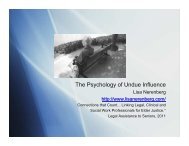Undue Influence: Definitions and Applications - California Courts ...
Undue Influence: Definitions and Applications - California Courts ...
Undue Influence: Definitions and Applications - California Courts ...
You also want an ePaper? Increase the reach of your titles
YUMPU automatically turns print PDFs into web optimized ePapers that Google loves.
judgment over them. Paradoxically, the researchers observe that in achieving power, caregivers<br />
experience a sense of powerlessness.<br />
M<strong>and</strong>eville <strong>and</strong> Hanson (2000) describe how caregivers of persons with developmental<br />
disabilities exercise power <strong>and</strong> control at both the individual <strong>and</strong> systems levels. At the<br />
individual level, caregivers <strong>and</strong> family members may use isolation <strong>and</strong> abusive tactics to<br />
maintain power <strong>and</strong> control. At the systems level, caregiving agencies depend on hierarchical<br />
<strong>and</strong> authoritative styles that grant powerful roles to caregivers in their relationships with<br />
consumers. The service models employed by agencies can also add to the isolation of both<br />
caregiver <strong>and</strong> consumer. Caregivers who must meet agency expectations to manage the lives of<br />
consumers <strong>and</strong> contain their behavior, without full consideration for their equality <strong>and</strong><br />
interdependence, can act out their authoritative role in an abusive manner.<br />
Persuasion in the Consumer Context<br />
The use of both normal <strong>and</strong> unfair persuasion has also been explored in the consumer<br />
context. In the mid-1950s advertisers began incorporating the insights of psychology into their<br />
work. “Motivation research” investigated the psychological reasons why individuals buy specific<br />
types of merch<strong>and</strong>ise <strong>and</strong> why they respond to specific advertising appeals. It was further used to<br />
influence their choices about goods <strong>and</strong> services. It viewed consumers as governed by<br />
irrationality <strong>and</strong> insecurity <strong>and</strong> moved by eroticism (Richards, MacRury, & Botterill, 2000).<br />
The more sinister aspects of marketing were revealed to the public in Vance Packard’s<br />
popular book The Hidden Persuaders (Packard, 1957), which explored how advertisers use<br />
psychological methods to tap into unconscious desires in order to persuade consumers to buy<br />
their products. Packard exposed how motivation research was used not only to probe people’s<br />
minds, but to control their actions, providing examples of how ad campaigns were tailored to<br />
exploit vulnerability <strong>and</strong> how subliminal messages were embedded into advertisement to<br />
produce desired responses. Among the studies he cited was one by James Vicary, who claimed to<br />
have provoked a rush to concession st<strong>and</strong>s at a New Jersey movie theater by flashing orders to<br />
buy food on the movie screen at speeds faster than the eye could perceive.<br />
Subsequent studies failed to support Packard’s theory or demonstrate that efforts to<br />
manipulate the unconscious did in fact lead to behavioral changes favorable to specific marketers<br />
83




